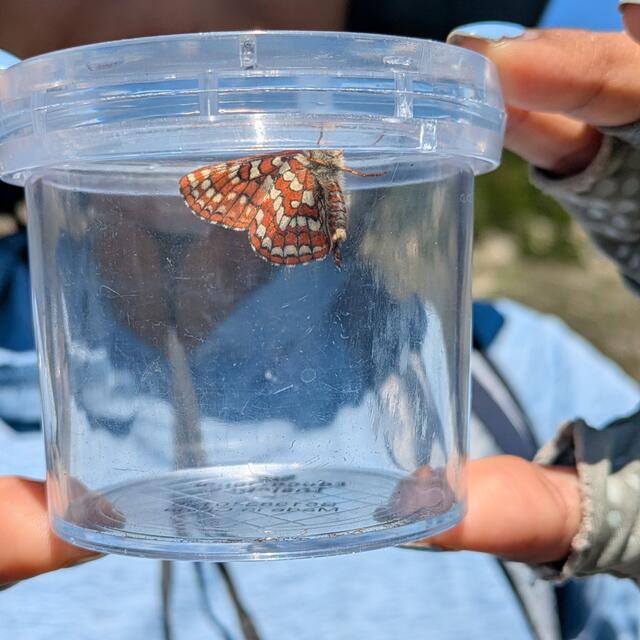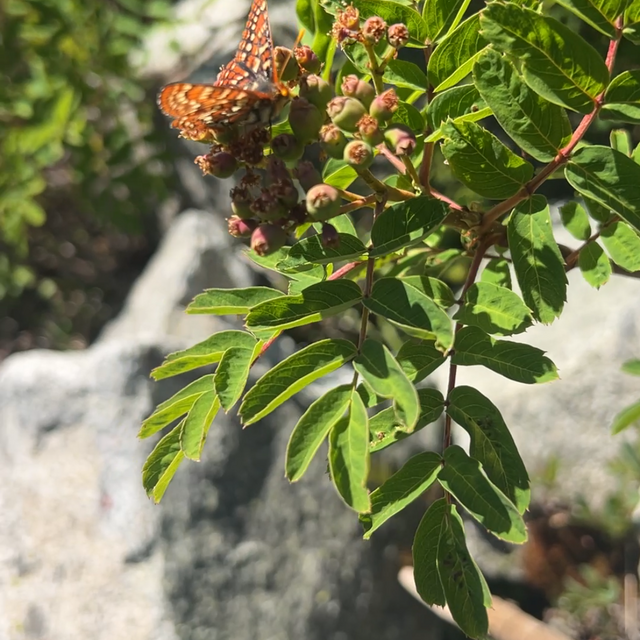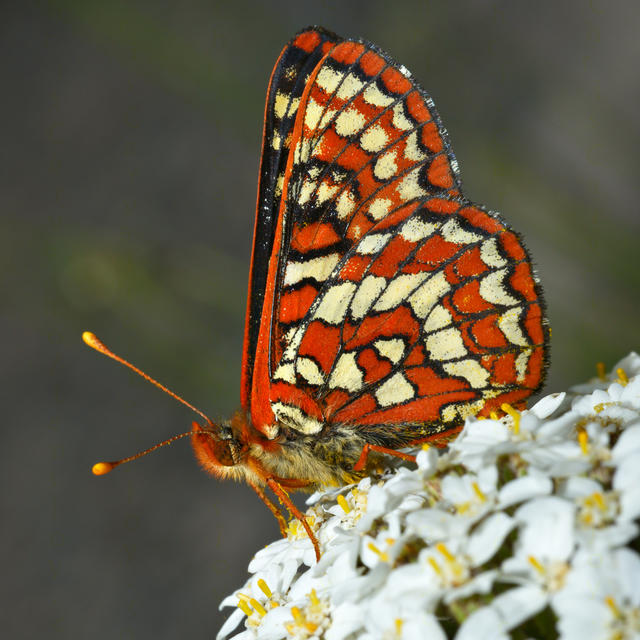Edith's Checkerspot
Euphydryas editha (Boisduval, 1852)
Family: Nymphalidae
Subfamily: Nymphalinae
Identification: Variable. Front wing rounded at tip. Upperside is black with red and pale yellow or white bands. Submarginal band of small yellow or white spots; wide postmedian band is red. Underside of hindwing with alternating bands of yellow-orange and cream.
Wing Span: 1 1/4 - 2 inches (3.2 - 5.1 cm).
Life History: Males perch or patrol all day to find females. Eggs are laid in groups on underside of leaves or on flowers of the host plant. Caterpillars eat leaves and flowers; sometimes using different host plants before and after hibernation. Young caterpillars live in loose silk webs; third- and fourth-stage caterpillars hibernate.
Flight: One brood; from March-May at low elevations, June-August at high elevations and in the north.
Caterpillar Hosts: Various species of paintbrush (Castilleja), beardtongues (Penstemon), lousewort (Pedicularis), owl's clover (Orthocarpus), Chinese houses (Collinsia), and plantain (Plantago).
Adult Food: Flower nectar.
Habitat: From sea level to treeline through diverse habitats including coastal chaparral, meadows, fields, foothills, open woods, alpine fellfields.
Range: Southern British Columbia and Alberta south to Baja California, Nevada, Utah, and Colorado.
Conservation: Two subspecies, the Bay Checkerspot (Euphydryas editha bayensis) and the Quino Checkerspot (E. e. quino) are listed as endangered under the Endangered Species Act of 1973.
NCGR: The bay checkerspot (subspecies bayensis) has The Nature Conservancy Global Rank of T1 - Critically imperiled because of extreme rarity (5 or fewer occurrences, or very few remaining individuals), or because of some factor of its biology making it especially vulnerable to extinction. (Critically endangered throughout its range). The other subspecies of Euphydryas editha have The Nature Conservancy Global Rank of G5 - Demonstrably secure globally, though it may be quite rare in parts of its range, especially at the periphery.
Management Needs: Protect remaining habitat from development and alteration. Refer to Fish & Wildlife Service recovery plans.
Please donate!
We depend on donations to keep Butterflies and Moths of North America freely available. We want to express our gratitude to all who showed their support by making a contribution this year. You can donate to support this project at any time.
Advertise with us!
Do you have a product or service that you think would interest BAMONA users? If you would like to advertise on this website, contact us by email, or use the contact form and select the "Advertising" category.
Verified Sightings
Displaying 1 - 24 of 797 verified sightings

Observation date: Jul 08, 2025
Submitted by: mongoose
Region: Pierce County, Washington, United States
Verified by: davidwdroppers
Verified date: Dec 03, 2025

Observation date: May 28, 2008
Submitted by: hank4044
Region: Lake County, Montana, United States
Verified by: J_Martineau
Verified date: Nov 03, 2025

Observation date: Jul 12, 2025
Submitted by: NikkiM
Region: Park County, Wyoming, United States
Verified by: J_Martineau
Verified date: Sep 05, 2025

Observation date: Jul 17, 2025
Submitted by: SCA PNW
Region: Chelan County, Washington, United States
Verified by: davidwdroppers
Verified date: Aug 24, 2025

Observation date: Jul 23, 2025
Submitted by: SCA PNW
Region: Chelan County, Washington, United States
Verified by: davidwdroppers
Verified date: Aug 24, 2025

Observation date: Apr 21, 2025
Submitted by: hasfitz5
Region: Contra Costa County, California, United States
Verified by: Ken Davenport
Verified date: Aug 20, 2025

Observation date: Jul 27, 2025
Submitted by: mstanek
Region: Flathead County, Montana, United States
Verified by: J_Martineau
Verified date: Aug 07, 2025

Observation date: May 27, 2025
Submitted by: DeerPark
Region: Thurston County, Washington, United States
Verified by: davidwdroppers
Verified date: Jul 16, 2025

Observation date: Jul 16, 2025
Submitted by: rabbitbinks
Region: British Columbia, Canada
Verified by: James Steen
Verified date: Jul 16, 2025

Observation date: Jul 07, 2025
Submitted by: mongoose
Region: Pierce County, Washington, United States
Verified by: davidwdroppers
Verified date: Jul 11, 2025

Observation date: Jul 06, 2025
Submitted by: NikkiM
Region: Carbon County, Montana, United States
Verified by: J_Martineau
Verified date: Jul 08, 2025

Observation date: Jun 13, 2025
Submitted by: ezeemonee
Region: Kern County, California, United States
Verified by: Ken Davenport
Verified date: Jun 17, 2025

Observation date: Jun 13, 2025
Submitted by: ezeemonee
Region: Kern County, California, United States
Verified by: Ken Davenport
Verified date: Jun 14, 2025

Observation date: Jun 13, 2025
Submitted by: ezeemonee
Region: Kern County, California, United States
Verified by: Ken Davenport
Verified date: Jun 14, 2025

Observation date: Apr 19, 2025
Submitted by: TomPeterson
Region: Contra Costa County, California, United States
Verified by: Ken Davenport
Verified date: May 04, 2025

Observation date: Jul 11, 2019
Submitted by: Sue Stewart
Region: British Columbia, Canada
Verified by: Paul Prappas
Verified date: Mar 20, 2025

Observation date: Jul 12, 2012
Submitted by: papilio1
Region: Washoe County, Nevada, United States
Verified by: Ken Davenport
Verified date: Jan 27, 2025

Observation date: Jul 12, 2012
Submitted by: papilio1
Region: Washoe County, Nevada, United States
Verified by: Ken Davenport
Verified date: Jan 27, 2025

Observation date: Jul 04, 2024
Submitted by: Robert Gorman
Region: Mono County, California, United States
Verified by: Ken Davenport
Verified date: Oct 10, 2024

Observation date: Jul 28, 2024
Submitted by: Robert Gorman
Region: Park County, Wyoming, United States
Verified by: J_Martineau
Verified date: Aug 11, 2024

Observation date: Jun 07, 2024
Submitted by: S.Reeves
Region: Clallam County, Washington, United States
Verified by: davidwdroppers
Verified date: Jun 20, 2024

Observation date: Jun 12, 2024
Submitted by: butterflies4us
Region: Inyo County, California, United States
Verified by: Ken Davenport
Verified date: Jun 19, 2024

Observation date: May 16, 2024
Submitted by: robertpb
Region: Mariposa County, California, United States
Verified by: Ken Davenport
Verified date: May 17, 2024

Observation date: May 01, 2024
Submitted by: glennfine
Region: Siskiyou County, California, United States
Verified by: Ken Davenport
Verified date: May 02, 2024
- 1 of 34
- next ›








